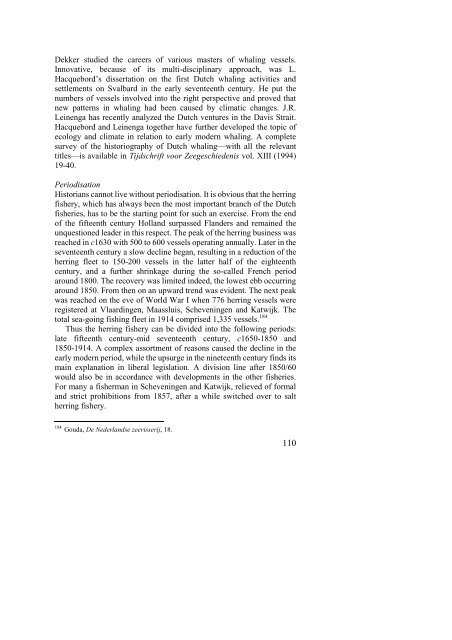The North Atlantic Fisheries, 1100-1976 - University of Hull
The North Atlantic Fisheries, 1100-1976 - University of Hull
The North Atlantic Fisheries, 1100-1976 - University of Hull
Create successful ePaper yourself
Turn your PDF publications into a flip-book with our unique Google optimized e-Paper software.
Dekker studied the careers <strong>of</strong> various masters <strong>of</strong> whaling vessels.<br />
Innovative, because <strong>of</strong> its multi-disciplinary approach, was L.<br />
Hacquebord’s dissertation on the first Dutch whaling activities and<br />
settlements on Svalbard in the early seventeenth century. He put the<br />
numbers <strong>of</strong> vessels involved into the right perspective and proved that<br />
new patterns in whaling had been caused by climatic changes. J.R.<br />
Leinenga has recently analyzed the Dutch ventures in the Davis Strait.<br />
Hacquebord and Leinenga together have further developed the topic <strong>of</strong><br />
ecology and climate in relation to early modern whaling. A complete<br />
survey <strong>of</strong> the historiography <strong>of</strong> Dutch whaling—with all the relevant<br />
titles—is available in Tijdschrift voor Zeegeschiedenis vol. XIII (1994)<br />
19-40.<br />
Periodisation<br />
Historians cannot live without periodisation. It is obvious that the herring<br />
fishery, which has always been the most important branch <strong>of</strong> the Dutch<br />
fisheries, has to be the starting point for such an exercise. From the end<br />
<strong>of</strong> the fifteenth century Holland surpassed Flanders and remained the<br />
unquestioned leader in this respect. <strong>The</strong> peak <strong>of</strong> the herring business was<br />
reached in c1630 with 500 to 600 vessels operating annually. Later in the<br />
seventeenth century a slow decline began, resulting in a reduction <strong>of</strong> the<br />
herring fleet to 150-200 vessels in the latter half <strong>of</strong> the eighteenth<br />
century, and a further shrinkage during the so-called French period<br />
around 1800. <strong>The</strong> recovery was limited indeed, the lowest ebb occurring<br />
around 1850. From then on an upward trend was evident. <strong>The</strong> next peak<br />
was reached on the eve <strong>of</strong> World War I when 776 herring vessels were<br />
registered at Vlaardingen, Maassluis, Scheveningen and Katwijk. <strong>The</strong><br />
total sea-going fishing fleet in 1914 comprised 1,335 vessels. 184<br />
Thus the herring fishery can be divided into the following periods:<br />
late fifteenth century-mid seventeenth century, c1650-1850 and<br />
1850-1914. A complex assortment <strong>of</strong> reasons caused the decline in the<br />
early modern period, while the upsurge in the nineteenth century finds its<br />
main explanation in liberal legislation. A division line after 1850/60<br />
would also be in accordance with developments in the other fisheries.<br />
For many a fisherman in Scheveningen and Katwijk, relieved <strong>of</strong> formal<br />
and strict prohibitions from 1857, after a while switched over to salt<br />
herring fishery.<br />
184 Gouda, De Nederlandse zeevisserij, 18.<br />
110















